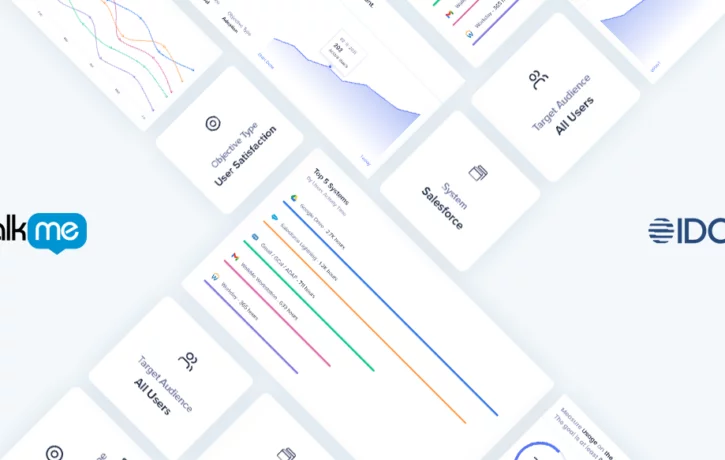We probably aren’t the first to tell you: Digital transformation is hard. Acquiring the right tech is a good start, but there’s so much more to it. It’s an always-on effort that requires a comprehensive strategy, and most companies don’t have that competency built into their organization, so notions are vague as to what’s required to succeed.
As the industry leader in digital adoption, WalkMe partnered with one of the world’s leading market research firms, IDC, to publish a guide outlining the considerations that anyone creating a digital adoption strategy must take into account.
According to Amy Loomis, Ph.D, Research Director for Future of Work at IDC, the digital adoption process consists of three phases, which she describes in detail:
- Laying the groundwork
- Realizing value
- Creating more value
In this three-blog series, we’ll look at each phase one by one, starting with laying the groundwork for a long future of digital adoption success from the beginning.
“Only 14% of organizations are very prepared to support employees as they onboard, upskill, and/or reskill to meet changing business needs.”
– IDC’s Future Enterprise Resiliency and Spending Survey, Wave 3, April 2021
Identify the core business challenges
Don’t jump into building content the minute a Digital Adoption Platform (DAP) is in your hands. You probably have instincts telling you what the problem is and how to solve it, but if your instincts aren’t supported by hard data, then you risk going down a fruitless path.
Collect as much information as possible to evaluate the current state so you can make data-driven decisions about:
- Which applications are the best targets for DAP solutions
- Whether the biggest challenges come from employee usage or customer usage, or both
- What target outcomes will best drive departmental or organizational goals for digital transformation
With a complete data portrait of your situation, you can define impactful, measurable objectives like:
- Increase paid conversions from 25% to 30% by September
- Decrease support tickets from our top 10 issues by 20% by EOY
- Decrease time spent creating an opportunity in Salesforce from 7 minutes to 1 minute by EOQ
Tip: Set up the WalkMe Systems Overview Dashboard right away to start collecting user engagement data before deploying any DAP content. If you see that 2,000 users are actively using an application, and you’re paying for 20,000 licenses, you can immediately demonstrate cost impact to the business and set clear benchmarks.
Choose your DAP team
It takes a village to make this work. Here are the main roles you need to designate within your organization for any successful DAP project. (Exact title names can vary depending on your organization’s preferred nomenclature.)
- Executive Sponsor — According to Prosci’s best practices in Change Management, the number one obstacle to the success of any project is the lack of visible and active executive sponsorship. Engage with senior leadership early to determine the right person for this crucial role.
- DAP Manager — You’ll need a project manager to drive your digital transformation strategy on a regular basis. This person is the primary point of contact for initiatives and also ensures visibility and collaboration across all stakeholders.
- DAP Builder — The DAP Builder is responsible for putting the plan into action: creating the content, testing it, and working with IT to deploy it. Builders typically have experience with development, UX, and training.
- Subject Matter Expert — This person is an expert on the target application. The Subject Matter Expert is consulted during planning, building, and deployment.
“I started to build out a team of digital adoption experts who are now basically spread throughout our entire system landscape, and each one of them owns a set or series of systems.”
– Head of Digital Adoption at a cloud computing platform company
Establish your governance model
Who is driving all of this digital transformation? Who’s accountable? How often will the team meet? It’s important to establish early on how current and future digital adoption projects will be operated and communicated.
A primary concern is whether to use a centralized or decentralized governance model. A centralized model is more economical and has better cross-departmental collaboration, but a decentralized model allows for faster responses to issues on the ground and empowers teams with decision-making ability. Or maybe you need a hybrid approach where you have regular leader forums and common IT tech that link departments and regions.
Regardless of which model works best in your organization, it’s important to identify which type you’re operating and who is responsible, accountable, and consulted as it is rolled out and implemented.
Ensure compliance and security
Identify the types of user information you’ll be storing, how it will be transferred, and how you’ll comply with HIPAA or GDPR user privacy regulations. And make sure IT is confident that the transfer of DAP data won’t compromise any existing networks or systems.
Compliance and security signoff with a Digital Adoption Platform isn’t much different than with any other platform or application you deploy in your environment, so there’s probably a document in your organization you can use as a template.
This part isn’t the most exciting, but it creates a strong foundation for everything else, so it’s good practice to document your proof of compliance and security early. For a head start, see our Security and Data Privacy page.
Stay tuned for Part 2 of this series, where we discuss best practices for understanding when you’ve achieved your stated business outcomes and how to demonstrate that success to your stakeholders. In the meantime, download a free copy of the full guide to hear the whole story straight from the analyst’s perspective.

